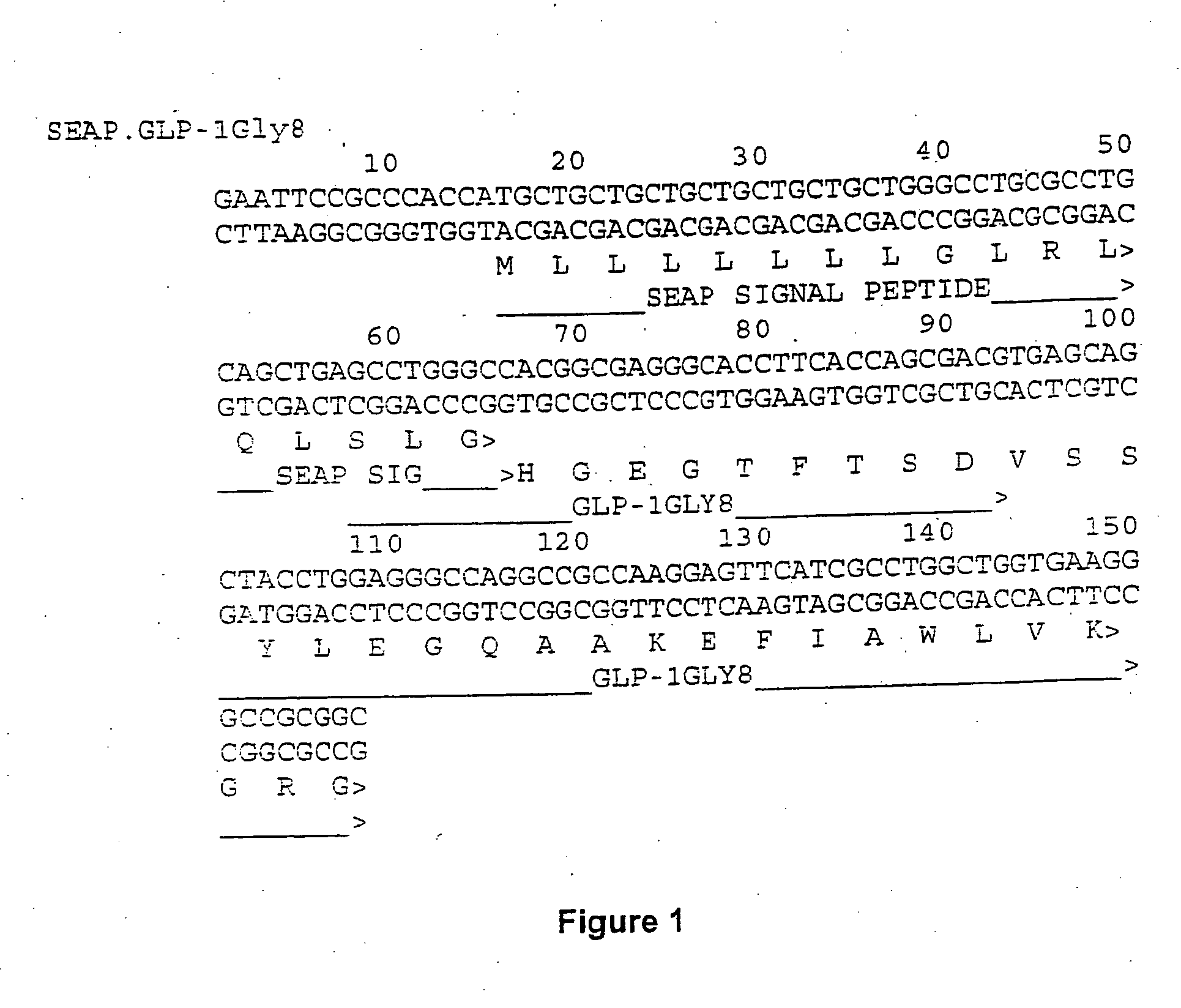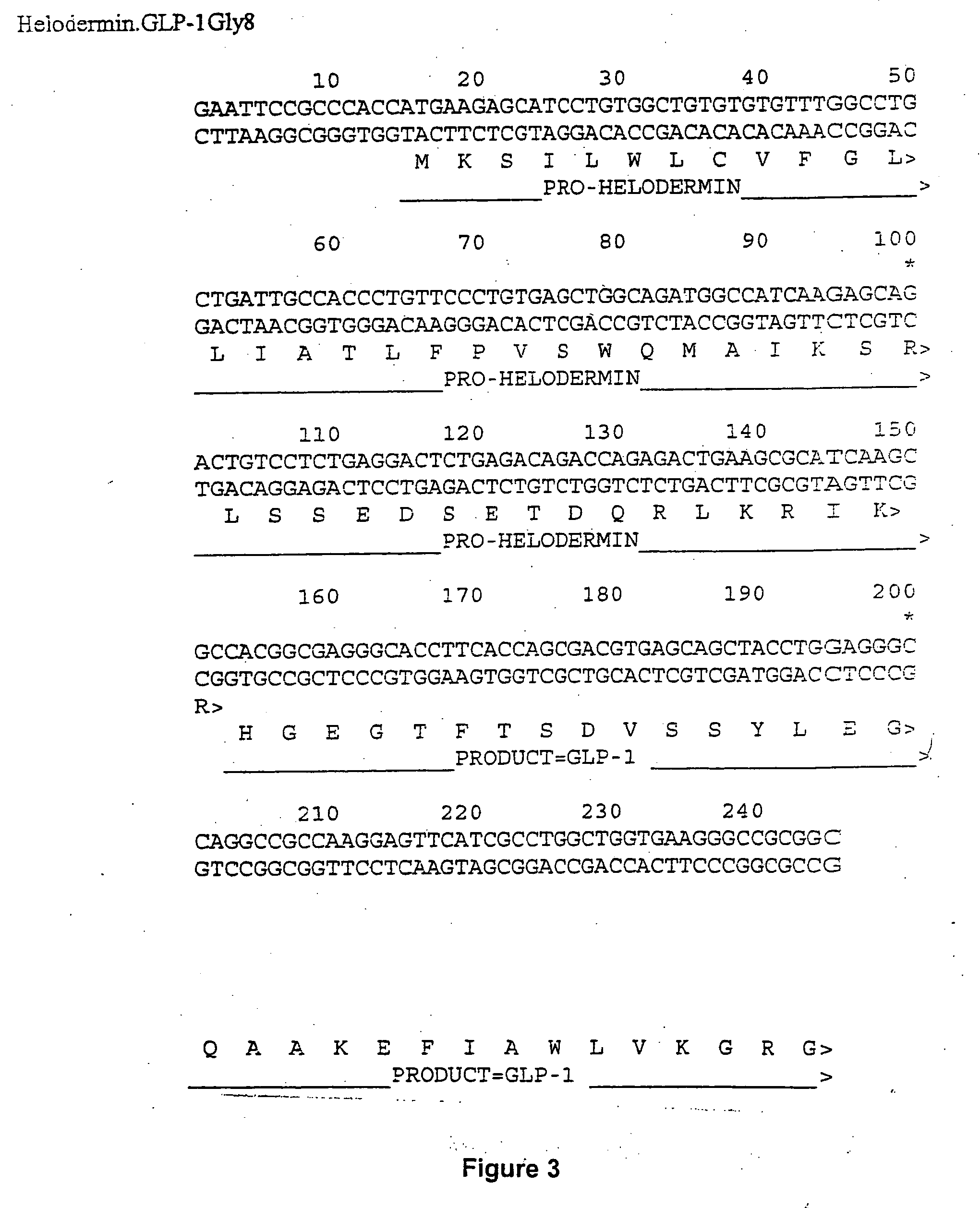Methods of treating diabetes and other blood sugar disorders
a technology for blood sugar disorders and diabetes, applied in the direction of dsdna viruses, genetic material ingredients, viruses/bacteriophages, etc., can solve the problems of increased insulin need, insufficient insulin need, and inability to meet the need for insulin
- Summary
- Abstract
- Description
- Claims
- Application Information
AI Technical Summary
Benefits of technology
Problems solved by technology
Method used
Image
Examples
example 1
GLP-1 Expression Constructs
Cloning of GLP-1
[0156] A nucleotide sequence encoding the signal peptide from secreted human alkaline phosphatase (SEAP) (Genbank Accession number CAA02290) linked to GLY-8 modified human GLP-1 (GLP-1-Gly-8) was generated by ligation of overlapping synthetic oligonucleotides. This sequence, shown in FIG. 1, is codon optimized and was cloned into the EcoRI and KpnI sites of the pCI expression vector from Promega that contains the CMV promoter, an intron and SV40 polyadenylation signal to create pCISEAPGLP-Gly-8. The signal peptide of SEAP targets the hybrid peptide for secretion and processing by signal peptidase at the SEAP / GLP-1 junction.
[0157] The coding sequence for GLP-1 was also linked to other leader sequences. pCISEAPGLP-Gly-8 was cut with EcoRI and BtrI which removes the SEAP leader and a portion of the GLP-1 sequence. The sequences were replaced with a fragment generated by overlapping oligonucleotides which contains the leader for proexendin-...
example 2
Cloning of Insulin Expression Cassettes
[0179] Rat preproinsulin I cDNA was amplified by PCR from Sprague-Dawley rat pancreatic cDNA (Clontech) and was cloned as an EcoRI fragment into pSP70 (Promega) to generate pSP70.rppins. The C / A junction of rat preproinsulin already contains a site which is cleaved by furin therefore no further modification of this site was done. The B / C junction was modified by removing the junction from pSP70.rppins with BsmFI and PpuMI and replacing the sequence with annealed synthetic oligonucleotides encoding a junction containing a furin cleavage site
(Oligonucleotide seq:(SEQ ID NO: 51)5705DA 5′ TTCTACACACCCCGCTCCAAGCGTGAAGTGGAG-3′;(SEQ ID NO: 52)5706DA 5′-GTCCTCCACTTCACGCTTGGAGCGGGGTGT-3′.
[0180] The pCI vector (Promega) was cut with NheI and BgIII which removes the CMV promoter and the intron. These sequences were replaced with annealed oligonucleotides containing a polylinker for cloning
(oligonucleotide seq:5′-GATCTCCTAGGGGTTTCGAAACCACTAGTAAGCTTACC...
example 3
GLP-1 Lowers Blood and Liver Triglycerides
[0182] GLP-1 expression improves fasting triglyceride levels and reduces lipid accumulation in a model of type 2 diabetes. An adenovirus expression vector carrying the furin cleavable exendin4GLP-1Gly8 fusion protein (SEQ ID NO:3) under the control of the CMV enhancer ubiquitin promoter was administered to obese diabetic db / db mice via tail vein injection. Virus was administered at a dose of 4e10 or 12e10 viral particles. A control group was treated with adenovirus containing no transgene at a dose of 12e10 viral particles. Fasting blood triglycerides were measured at 2 weeks and 4 weeks following virus administration. When the animals were sacrificed at the 4 week time point, the fasting triglycerides were significantly lower in both of the treated groups (p=0.003, p=0.05) compared to the obese control group treated with empty vector. (FIG. 36).
[0183] Following sacrifice of the animals, lipid accumulation in the liver was visualized using...
PUM
| Property | Measurement | Unit |
|---|---|---|
| Electrical resistance | aaaaa | aaaaa |
| Therapeutic | aaaaa | aaaaa |
Abstract
Description
Claims
Application Information
 Login to View More
Login to View More - R&D
- Intellectual Property
- Life Sciences
- Materials
- Tech Scout
- Unparalleled Data Quality
- Higher Quality Content
- 60% Fewer Hallucinations
Browse by: Latest US Patents, China's latest patents, Technical Efficacy Thesaurus, Application Domain, Technology Topic, Popular Technical Reports.
© 2025 PatSnap. All rights reserved.Legal|Privacy policy|Modern Slavery Act Transparency Statement|Sitemap|About US| Contact US: help@patsnap.com



